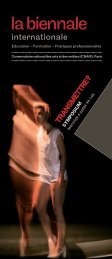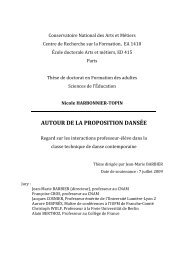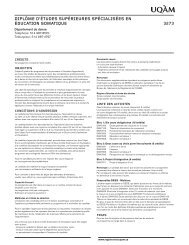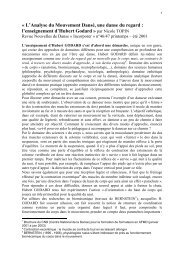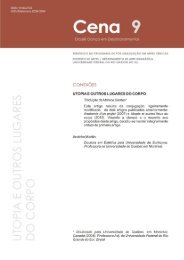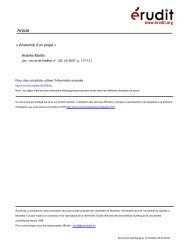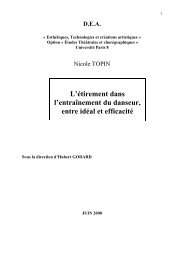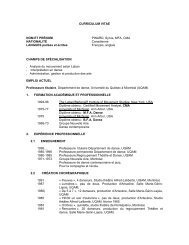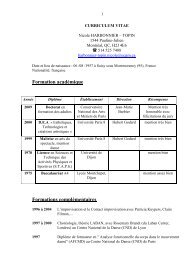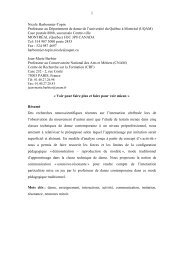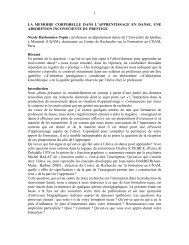Day 2 - Département de danse - UQAM
Day 2 - Département de danse - UQAM
Day 2 - Département de danse - UQAM
You also want an ePaper? Increase the reach of your titles
YUMPU automatically turns print PDFs into web optimized ePapers that Google loves.
theatre. In her quest to spread her eugenics and birth control propaganda, Stopes adapted her real-life story to theatre through<br />
mo<strong>de</strong>rn drama’s emerging focus on subjectivism. Retelling her witness narrative through performance allowed Stopes to stage<br />
and embody her own transformation into both subject and object of her research on sexual education. This paper will engage<br />
with Stopes’s attempts to enter theatrical history from the edges of aca<strong>de</strong>mia and scientific research. Although Stopes’s<br />
dramas foregroun<strong>de</strong>d avant-gar<strong>de</strong> views on women’s sexual and intellectual repression, her theatrical efforts were not able to<br />
replicate, nor generate, calls for collective, feminist action.<br />
2:15-4:15pm<br />
Board Meeting for Theatre Research in Canada Rm 141<br />
3:45pm — break<br />
4:00pm-5:30pm<br />
a) Technophilic Theatre Bishop<br />
Open Panel Mo<strong>de</strong>rator: Henry Daniel (Simon Fraser University)<br />
“Technostalgia: the Allure of Outmo<strong>de</strong>d Technology in Contemporary Performance.” Rebecca<br />
Harries (Bishop’s University)<br />
The subject of this paper is intermedia and theatre, as informed by phenomenological and materialist approaches to theatre,<br />
including the work of Don Ih<strong>de</strong> and Philip Auslan<strong>de</strong>r. Instead of focusing on the discourse of futurity, of technology in the<br />
theatre to bring the art form into the twenty-first century, this paper examines how technology in performance can evoke<br />
evanescent phenomena and i<strong>de</strong>as of the past.<br />
Technology in Theatre, certainly since the manifestos of Futurism and the Bauhaus, has been associated with future<br />
looking, cutting edge experimentation. In contemporary performance, this is often poignantly linked to the recapture of lost time<br />
as in Andre Bazin’s famous phenomenology of film. Support for this belief can be seen in the dazzling opera Death and the<br />
Powers by Tod Machover and the MIT Media Lab (2012) and in Michel Lemieux and Victor Pilon’s playful and moving<br />
evocation of Canadian filmmaker Norman McLaren, Norman (2010).<br />
Nostalgia can also be linked to the material presence of outmo<strong>de</strong>d technologies in performance. In several contemporary<br />
performances the use of ol<strong>de</strong>r technologies, when newer ones are readily available, seems to offer the audience an imperiled<br />
and fragile world. In a recent production by Ontoerend Goed, All That Is Wrong (2012), the sli<strong>de</strong>show and a chalk board<br />
played starring roles, somewhat jarringly juxtaposed with one of the performer’s reading one of the other’s Facebook posts.<br />
Furthermore, the romance of the sli<strong>de</strong> projector was revisited at Bishop’s University, as a component in Bishop’s University<br />
Honours stu<strong>de</strong>nt Helen Monroe’s thesis performance of Sam Shepard’s Savage Love.<br />
These examples from different economic strata of performance not only share a ‘technostalgia’. They also relate to<br />
current cultural phenomena that recapture time through outmo<strong>de</strong>d communication and technologies, including Ed Conroy’s<br />
recent threnody for vi<strong>de</strong>o rental as performance in TOBlog and online phenomena like Found Footage and Postsecret.<br />
Arguably, such “technostalgia” is both the vehicle and the material engagement with a past, often imagined as personal and<br />
fragile.<br />
“Auteur-ship on the Cutting-Edge: Robert Lepage’s Scenographic Dramaturgy.” Melissa Poll<br />
(Royal Holloway, University of London)<br />
Robert Lepage’s innovative use of technology—i.e. motion <strong>de</strong>tectors worn by performers enabling their vocal variations and<br />
movements to cue scenic shifts, 3D imaging etc.—has given rise to a twenty-first century incarnation of auteur-ship—<br />
scenographic dramaturgy. Composed of three dramaturgical techniques which I’ve theorized and will <strong>de</strong>tail in this paper—<br />
architectonic scenography, kinetic bodies and historical-spatial mapping—scenographic dramaturgy is the progeny of what<br />
Roger Planchon termed écriture scénique; it re-”writes” extant texts via highly visual and physical staging conceits. Through<br />
performance texts based in scenographic dramaturgy, Lepage renegotiates, re-contextualizes and, therefore, re-authors<br />
canonical works by making meaning in new ways. This paper situates Robert Lepage’s cutting-edge scenography as it figures<br />
in the evolution of auteur-ed work, including the auteur genre as posited by French New Wave cinema and seminal conflicts<br />
surrounding authorship and authority in theatre. By interrogating auteur-ly approaches to extant texts, I will <strong>de</strong>monstrate that in<br />
the case of Lepage’s auteur theatre, performance text is content.<br />
“The Screen is the Thing: Multiplicity and Virtual Spectatorship in Hamlet Live.” Cynthia Ing<br />
(University of Guelph)<br />
What do pop icon Whitney Houston and Hamlet have in common? On the same night as a production of Hamlet Live (Toronto,<br />
2012), the news of Houston’s unexpected <strong>de</strong>ath took over the headlines and went viral on numerous social media platforms.<br />
The <strong>de</strong>ath of Houston would normally have no effect on traditional live theatre since an in-theatre audience is disconnected<br />
from any online presence. Hamlet Live’s audience, however, was split between live and virtual spectatorship, a reality that<br />
produced a unique form of non-linear, intermediality into the performance. In Hamlet Live, the multiplicity of online<br />
engagements during the performance created a liminal space for virtual spectators to engage with in a plethora of ways. As a<br />
17



